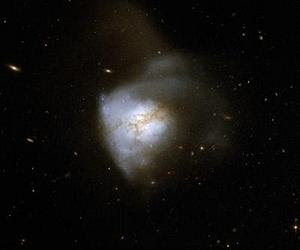This star forming core of Arp 220 is only about 3,000 light years across, compared to our own galaxy which measures about 60,000 light years.
The galaxy Arp 220 is home to several giant star clusters-about 10 million solar masses-that are twice as massive as any comparable star cluster in the Milky Way Galaxy.
McMaster University's Christine Wilson is captivated by this turbulent galaxy that provides such a target-rich environment for watching stars form.
The reason that star formation is going wild is that the galaxy is in the late stages of a merger between two larger galaxies.
"This is a nearby look at a phenomenon that was common in the early universe, when many galaxies were merging," says Wilson.
At this week's meeting of the American Association for the Advancement of Science (AAAS) in Vancouver, Wilson will be presenting findings on Arp 220's dazzling rate of star formation-200 times faster than our own Milky Way.
What's more, it's all happening in a much smaller space. The star forming core of Arp 220 is only about 3,000 light years across, compared to our own galaxy which measures about 60,000 light years.
Using the Herschel Space Observatory, an orbiting telescope, Wilson's group has found Arp 220 to have large amounts of very warm molecular hydrogen gas, a surprising find that implies molecular hydrogen is the dominant coolant in the high-temperature gas.
Wilson's team has also observed a massive wind from the centre of the galaxy, removing molecular gas from the central star forming core.







No comments:
Post a Comment